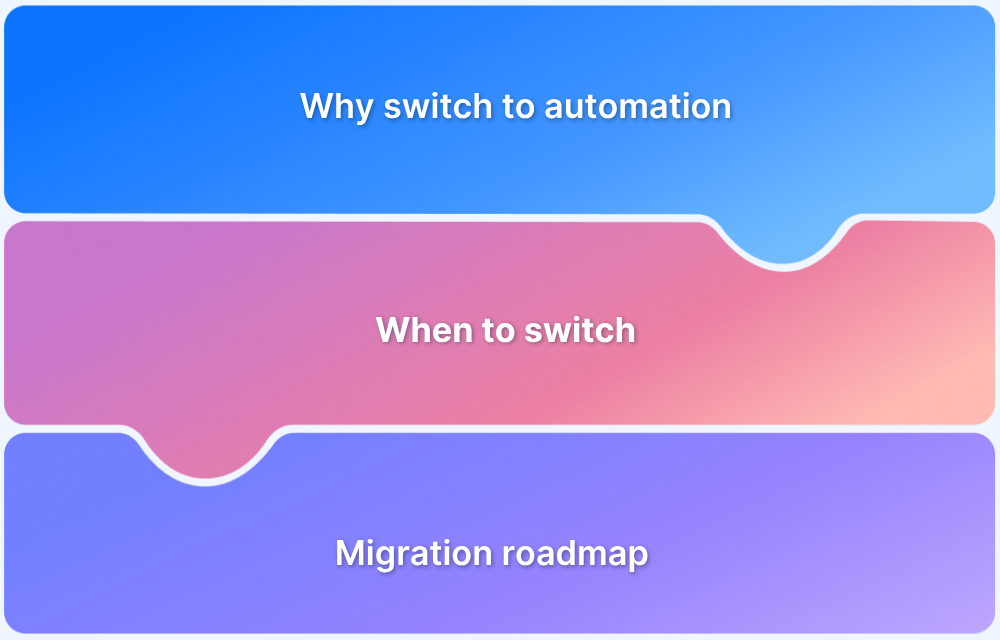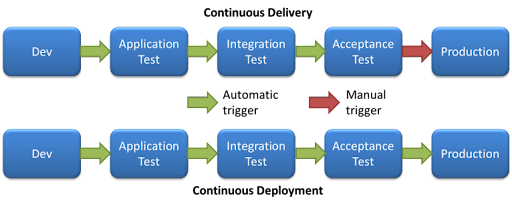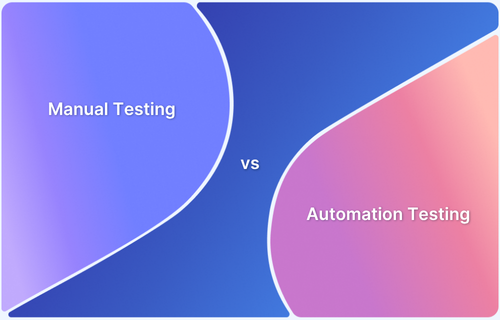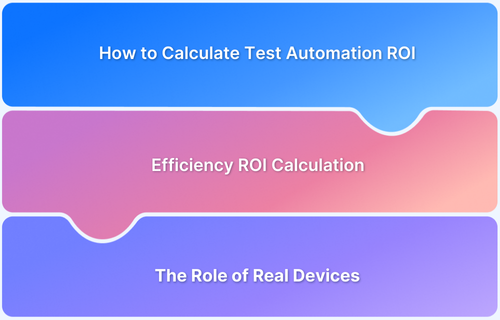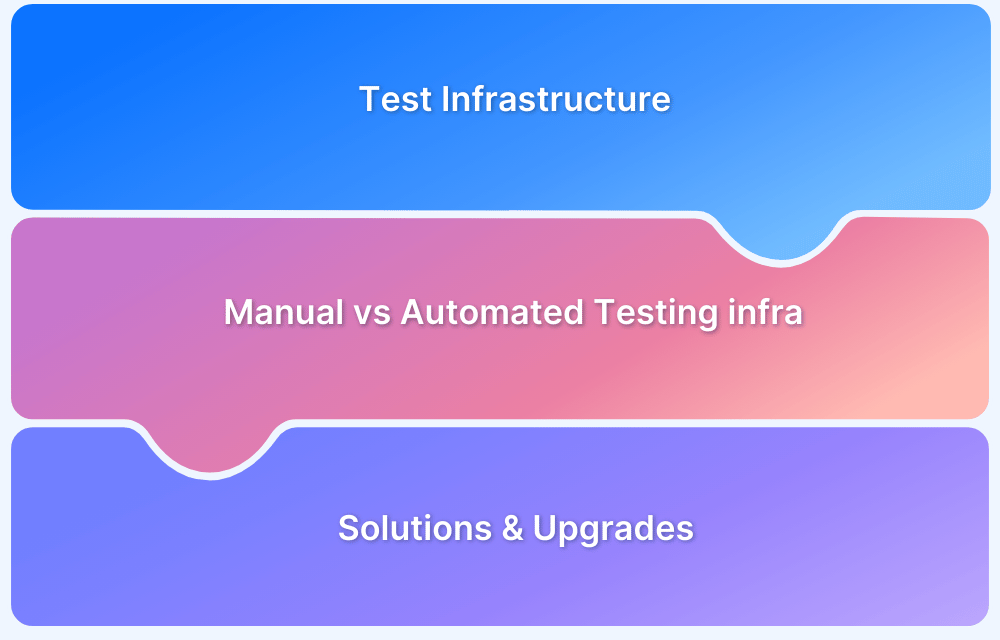Transitioning from manual to automation testing is key to faster, more reliable software delivery. Manual testing relies on human effort, while automation uses tools and scripts to run repetitive tests efficiently. With the right tools and coding skills, testers can reduce errors, save time, and focus on higher-value tasks.
Overview
What is Manual Testing
Manual Testing is the process of manually executing test cases without the use of automation tools. Testers act as end-users, checking software functionality, usability, and identifying bugs by following predefined test plans.
What is Automation Testing
Automation Testing is the process of using software tools and scripts to automatically execute test cases, compare actual outcomes with expected results, and report defects. It’s ideal for repetitive, time-consuming tasks like regression, load, and performance testing.
When to Move from Manual to Automation Testing
- Repetitive Test Cases
- Time-Intensive Test Cycles
- Frequent Builds or Releases
- Large Test Suites
- Critical Applications
- Cross-Platform Testing
- Budget for Tools and Expertise
- Need for Performance or Load Testing
How to switch from Manual to Automation Testing
- Understand the ROI from automation and get buy-in from the stakeholders
- Decide what to Automate
- Select the Right Framework(s) for the project
- Set bite-sized targets and a rapid learning curve
- Aim for thorough visibility and continuous testing
- Have a well-defined lifecycle for your automation test suite
This article explores why the transition from manual to automation testing matters and explains how you can make this transition.
What is Manual Testing
Traditional manual testing requires testers to manually investigate defects in software by adhering to a predefined test plan comprising a number of test cases. The testers take it upon themselves to analyze the behaviour of the app and check if the functionality is synchronous with the expected behaviour.
Testers identify bugs and report them to developers who fix them after replicating the errant behaviour. This can become challenging for a test lead/manager especially when the timelines are shorter.
Read More: Top 15 Manual Testing Tools
When to use Manual Testing
Manual testing is useful when the QA process requires cognitive and behavioural abilities beyond that of a software. It is recommended to use Manual testing in situations like:
- Exploratory Testing
- Usability testing
- Ad-Hoc testing
Also, for scenarios where:
- The testers need a quick turnaround on a particular scenario with a clear intent. Since automation tests take time to set up, it might be faster to test one-off scenarios manually. However, scenarios that require a repetition with different inputs would be better off being tested through automation testing.
- The projects are short-term with a small number of feature tests. Since automation is time-consuming to set up, small projects can be tested manually.
- End-user usability is of importance, as no machine is accurate enough to decide the satisfactoriness of a user journey without an actual user testing it.
All of these test scenarios can now be expanded into a set of positive and negative test cases.
What is Automation Testing
Automation testing primarily uses frameworks to execute test cases. Each framework is unique to an extent and is powered by scripts adhering to the rules of the framework in question. These frameworks have components like:
- Function libraries
- Test Data Sources
- Object Details
- Other reusable modules
These frameworks can be classified as
Read More: How to write Test Cases with Examples
When to use Automation Testing
Automation tests work best when we need to run a large volume of repetitive tests with differing inputs. For example, Data-Driven testing of a large number of regression tests. As in this case, the functionality has essentially remained the same, it will not require much manual oversight.
Also, when human resources are better utilized in other tasks which require greater cognitive effort, it is better to run automated tests. Parallel testing offers a great avenue to run a large volume of tests without compromising test accuracy.
Thus, to recap, we have identified a couple of important caveats before focussing on the transition from manual to automation testing:
- Not everything can be automated
- Manual testing cannot be done away with completely (at least in some areas).
Try Automation Testing on BrowserStack for Free
Key Differences between Manual and Automation Testing
Here’s a comparison to help you understand the key differences between manual and automation testing:
| Aspect | Manual Testing | Automation Testing |
|---|---|---|
| Execution Speed | Slower, dependent on human effort | Faster, as tests are executed by scripts |
| Accuracy | Prone to human errors | Highly accurate with minimal chances of errors |
| Repetition | Time-consuming and monotonous for repeated tasks | Efficiently handles repetitive tasks |
| Cost Over Time | Lower initial cost but higher in the long term | Higher initial cost but cost-effective over time |
| Test Coverage | Limited due to time constraints | Broader, allowing more scenarios to be tested |
| Suitability | Ideal for exploratory or ad-hoc testing | Best for regression, load, and performance tests |
| Maintenance | Requires no setup or script maintenance | Requires regular updates to test scripts |
| Scalability | Limited scalability with increased workload | Easily scalable with additional test scripts |
Why move from Manual to Automation Testing?
Here are the top reasons to make the switch from manual to automated testing:
- Faster Test Execution: Automated tests run significantly faster than manual ones. It enables quicker feedback and shorter development cycles.
- Improved Accuracy: Automation ensures consistent and reliable test results by eliminating human errors.
- Enhanced Test Coverage: Automation allows for broader testing, covering more scenarios and configurations.
- Cost-Effectiveness: While the initial setup cost is higher, automation reduces long-term costs by saving time and resources.
- Scalability and Flexibility: Automation easily scales to handle growing test suites, making it ideal for agile and continuous delivery pipelines.
- Focus on Strategic Testing: With repetitive tasks automated, QA teams can dedicate more time to exploratory and usability testing.
How to switch from Manual to Automation Testing
As a quality assurance leader, once you have identified the need to automate a portion of your existing test portfolio, it is important to consider the steps required to achieve your goal. Here are a few simple guidelines to help make that decision:
Step 1. Understand the ROI from automation and get buy-in from the stakeholders
Change is inevitable, however, necessary. But for change to be accepted, the stakeholders need to be convinced of the ROI arising from that change. The Return on Investment from automation can be best described in terms of:
- Increased speed of test coverage: Automated tests can work wonders for repetitive test cases and help minimize the cognitive load for data-driven regression testing allowing your team to work in a more agile way across sprints.
- Reduced cost: Though some may claim that the initial cost of setting up an automated test framework is higher than standard manual testing, one will only reap increasing dividends by setting up the infrastructure. Studies have shown that the costs of test automation reaches a positive balance after the third test cycle, and this can be speeded up even further in an agile scenario.
- Providing a baseline for Continuous Integration and DevOps: An automation test suite is a foundation for transitioning into a scalable CI/CD and DevOps model. Continuous Testing is the execution of automated tests at regular intervals made to correspond to code changes. These tests are conducted as part of the software delivery pipeline and provide faster feedback on changes to the repository.
- Increased Accuracy and Productivity: Test automation provides faster test coverage with data-driven accuracy and frees up resources to divert their attention to more critical tasks thereby increasing overall productivity as well.
Thus, benefits of Automation Testing can provide better ROI to the business with its high efficiency.
Step 2. Decide what to Automate
The key decision in any test-automation strategy is to select which test suites to automate. Some of the tests which are most suitable for automation are as follows:
- Regression Test Suites: These are usually voluminous, require the same set of variables to be used as input and are usually run several times during the development
- Data-Driven Test Suites: Even a lot of functional tests are data-driven and need to be tested with numerous divergent data sets to test a variety of positive and negative scenarios.
- Performance Testing Suites: Tests to monitor system performance under different circumstances can be automated to reduce test times.
Run Automated Tests on Real Device Cloud
Step 3. Select the Right Framework(s) for the project
Selecting the right framework is essential for streamlined testing. Test frameworks are often licensed and need time to set up. Moreover, it is important the team is well-versed with the tool for delivering accurate results. Selecting the right framework depends upon:
- The Nature of the Software: Understand the primary audience and thus the main runtime system for your software. If it is desktop-based, a tool like Selenium is preferable. If it is mobile-first then Appium can be considered, and so on.
- Programmer Skillset: It is vital to choose frameworks that are compatible with your team’s forte and experience. Some popular languages for test automation frameworks are Java, JavaScript, Ruby, C#, etc. It is best to select a framework that supports the programming language preferred for practice by the team.
- Cost: Automation is sometimes expensive. Depending on your need you may choose a licensed framework like QTP or an open-source framework like Selenium Webdriver.
Read More: How to calculate Test Automation ROI
Step 4. Set bite-sized targets and a rapid learning curve
Test automation is often touted as a silver bullet in the world of QA. However, the journey from a manual to an automated test suite might not be smooth. It’s best to start with small goals. Automate the test suite that is most used in regression testing. Isolate any common errors, and iteratively expand the scope and complexity of the automation to increase test coverage.
Step 5. Aim for thorough visibility and continuous testing
Continuous Integration (CI), Continuous Deployment (CD), and Continuous Testing (CT) are all key components in Agile. While CI enables developers to merge code changes to the repository on a daily basis, CT is required to ensure that those changes work as expected.
Read More: Role of Automation Testing in CI/CD
Step 6. Have a well-defined lifecycle for your automation test suite
Once the automation suite has been set up (sometimes at the cost of considerable time, effort and finances) it is vital to ensure there is a clear roadmap to implement and maintain the same. Some common pitfalls of test automation include:
- lack of specific goals,
- inadequately testable applications,
- low visibility of the automation ROI across the organization.
When should you switch from Manual Testing to Automation Testing?
Switching from manual to automation testing is not an all-or-nothing decision. It depends on the needs of your project and the nature of your tests. Here is how to identify the right time to make the switch:
Key Indicators to Transition to Automation:
- Repetitive Test Cases: If you run the same test cases repeatedly (for example, regression or smoke tests), automation can save time and reduce effort.
- Time-Intensive Test Cycles: Long testing cycles that delay delivery timelines strongly indicate that automation can help speed things up.
- Frequent Builds or Releases: For projects using Agile or CI/CD methodologies, automation ensures rapid and consistent feedback during each build or release.
- Large Test Suites: When the number of test cases grows beyond what manual testing can handle efficiently, automation becomes essential to maintain coverage.
- Critical Applications: Automation reduces the risk of human error in software where accuracy and consistency are paramount (for example, financial, healthcare, or aviation systems).
- Cross-Platform Testing: If your application needs testing across multiple devices, operating systems, or browsers, automation simplifies and standardizes the process.
- Budget for Tools and Expertise: Automation testing requires an initial investment in tools and training. Transition when your project has the resources to sustain this.
- Need for Performance or Load Testing: Scenarios that involve high user volumes or system stress are best handled with automation tools.
Read More: Best Automation Testing Tools
Benefits of moving from Manual Testing to Automation Testing?
Here are some of the benefits of Automation Testing:
- Faster Testing: Speeds up execution, enabling quicker releases.
- Higher Quality: Ensures consistent, reliable, and bug-free software.
- Better Test Coverage: Tests more scenarios and platforms in less time.
- Increased Efficiency: Frees teams to focus on exploratory and creative testing.
- Scalability: Handles growing test suites and cross-platform needs with ease.
- Cost Savings: Reduces long-term costs with reusable scripts and time savings.
- Continuous Feedback: Integrates with CI/CD for rapid issue detection.
- Data Insights: Provides detailed reports for informed decision-making.
- Stakeholder Confidence: Builds trust with consistent, high-quality releases.
- Faster-Time-To-Market: Supports agile workflows and faster time-to-market.
Balancing between Manual and Automation Testing
Balancing manual and automation testing is essential to create a comprehensive, efficient, and effective QA strategy. Each approach has unique strengths, and combining them ensures optimal use of resources, better test coverage, and higher software quality.
Here is why you must strike a balance between manual and automation testing methods:
1. Leverage the Strengths of Both Approaches
- Manual Testing excels in uncovering usability issues, exploring edge cases, and adapting to changes.
- Automation Testing is unmatched in speed, consistency, and scalability for repetitive or large-scale test cases.
2. Optimize Resource Utilization
- Manual testing requires skilled human testers for creative and exploratory tasks.
- Automation testing saves time on repetitive tasks, freeing resources for strategic efforts.
3. Improve Test Coverage
- A balanced approach ensures you can test broad scenarios (via automation) and dive deep into specific user interactions (via manual testing).
4. Adapt to Different Project Needs
- Every project is unique; balancing allows you to tailor your QA efforts to suit varying requirements, timelines, and complexities.
5. Ensure Cost-Effectiveness
- Over-automating can lead to high upfront costs and maintenance.
- Over-relying on manual testing can result in inefficiencies for repetitive tasks.
Read More: Test Automation Best Practices
Why Choose BrowserStack Automate for Automation Testing?
BrowserStack Automate offers a comprehensive suite of features designed to enhance and streamline your automation testing processes:
- Extensive Real Device Cloud: Gain instant access to over 20,000 real desktop and mobile devices, including the latest models from leading manufacturers, ensuring your tests accurately reflect real user conditions.
- Broad Framework and Language Support: Seamlessly integrate with popular test frameworks like Selenium, Playwright, Puppeteer, and Cypress, and write tests in languages such as Java, Node.js, Python, Ruby, and C#, aligning with your team’s
- Robust CI/CD Integrations: Easily incorporate BrowserStack into your Continuous Integration and Continuous Deployment pipelines, facilitating rapid and reliable testing within your development workflow.
- Advanced Debugging Tools: Utilize comprehensive logs, video recordings, and interactive debugging features to swiftly identify and resolve issues, enhancing the efficiency of your testing cycles.
- Comprehensive Test Reporting and Management: Access detailed test reports and management capabilities that provide insights into test performance and outcomes, enabling data-driven decisions and effective test suite maintenance.
Conclusion
Test automation has become indispensable for organizations seeking to make the most out of Agile Software Development practices and incorporate CI/CD and DevOps into their development plans. Though manual testing still retains a niche, transitioning to automation can result in faster test coverage with enhanced accuracy. Performing automation tests on real devices would help generate more accurate results.
Use testing platforms like BrowserStack’s real device cloud, which provides 3500+ real browsers and devices for a wider coverage. It allows parallel testing and supports integrations with popular CI/CD tools such as Jira, Jenkins, TeamCity, and Travis CI to ensure streamlined Automation Testing.
